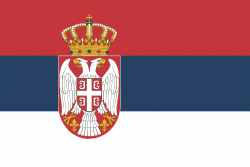Novi Bečej (Novi Bečej)
Novi Bečej (Нови Бечеј, Törökbecse) is a town and municipality located in the Central Banat District of the autonomous province of Vojvodina, Serbia. The town has a population of 13,133, while Novi Bečej municipality has 23,925 inhabitants.
Novi Bečej means "New Bečej". In the past it was known as Turski Bečej (Турски Бечеј, "Turkish Bečej"), while the current town of Bečej, across the river Tisa (in the Bačka region) was in the past known as Stari Bečej (Serbian Cyrillic: Стари Бечеј, "Old Bečej").
There are several theories about town's name origin. The first one is that it derives from Castellum de Beche, which was the name of the fort located near today's town center. The other theory is that the name was given after the family Wechey, which used rule the settlement and the land around modern-day Novi Bečej. The town was also known as Turski Bečej (Турски Бечеј). In 1919 it was renamed Novi Bečej (Нови Бечеј).
For a short period of time after the World War II, from 1947 to 1952, the name of the town was Волошиново (Vološinovo) after the Red Army Colonel Lavrenty Voloshinov who died in the battle for the liberation of the town.
In Serbian, the town is known as Novi Bečej (Нови Бечеј), in Hungarian as Törökbecse and in German as Neu-Betsche. Both Serbian and Hungarian are officially used by municipal authorities.
Novi Bečej means "New Bečej". In the past it was known as Turski Bečej (Турски Бечеј, "Turkish Bečej"), while the current town of Bečej, across the river Tisa (in the Bačka region) was in the past known as Stari Bečej (Serbian Cyrillic: Стари Бечеј, "Old Bečej").
There are several theories about town's name origin. The first one is that it derives from Castellum de Beche, which was the name of the fort located near today's town center. The other theory is that the name was given after the family Wechey, which used rule the settlement and the land around modern-day Novi Bečej. The town was also known as Turski Bečej (Турски Бечеј). In 1919 it was renamed Novi Bečej (Нови Бечеј).
For a short period of time after the World War II, from 1947 to 1952, the name of the town was Волошиново (Vološinovo) after the Red Army Colonel Lavrenty Voloshinov who died in the battle for the liberation of the town.
In Serbian, the town is known as Novi Bečej (Нови Бечеј), in Hungarian as Törökbecse and in German as Neu-Betsche. Both Serbian and Hungarian are officially used by municipal authorities.
Map - Novi Bečej (Novi Bečej)
Map
Country - Serbia
 |
 |
| Flag of Serbia | |
Continuously inhabited since the Paleolithic Age, the territory of modern-day Serbia faced Slavic migrations in the 6th century, establishing several regional states in the early Middle Ages at times recognised as tributaries to the Byzantine, Frankish and Hungarian kingdoms. The Serbian Kingdom obtained recognition by the Holy See and Constantinople in 1217, reaching its territorial apex in 1346 as the Serbian Empire. By the mid-16th century, the Ottomans annexed the entirety of modern-day Serbia; their rule was at times interrupted by the Habsburg Empire, which began expanding towards Central Serbia from the end of the 17th century while maintaining a foothold in Vojvodina. In the early 19th century, the Serbian Revolution established the nation-state as the region's first constitutional monarchy, which subsequently expanded its territory. Following casualties in World War I, and the subsequent unification of the former Habsburg crownland of Vojvodina with Serbia, the country co-founded Yugoslavia with other South Slavic nations, which would exist in various political formations until the Yugoslav Wars of the 1990s. During the breakup of Yugoslavia, Serbia formed a union with Montenegro, which was peacefully dissolved in 2006, restoring Serbia's independence as a sovereign state for the first time since 1918. In 2008, representatives of the Assembly of Kosovo unilaterally declared independence, with mixed responses from the international community while Serbia continues to claim it as part of its own sovereign territory.
Currency / Language
| ISO | Currency | Symbol | Significant figures |
|---|---|---|---|
| RSD | Serbian dinar | дин or din. | 2 |
| ISO | Language |
|---|---|
| BS | Bosnian language |
| HU | Hungarian language |
| SR | Serbian language |















